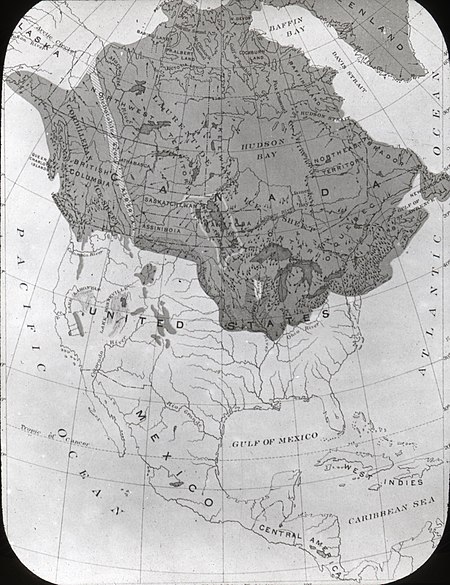Laurentide glaciation: Difference between revisions
Jump to navigation
Jump to search

George Swan (talk | contribs) (add reference) |
mNo edit summary |
||
| (3 intermediate revisions by 2 users not shown) | |||
| Line 1: | Line 1: | ||
{{subpages}} | {{subpages}} | ||
[[File:Glacial Period (4843358055).jpg | thumb | 450px | 19th century estimate of the boundaries of the Laurentide glaciation. Note: Alaska (and Siberia) were not covered by ice as prevailing wind patterns did not bring in moisture laden air, so almost no snow fell there, and thus these areas were glacier free.]] | |||
The '''Laurentide glaciation''' is the most recent continent-spanning glacier in [[North America]].<ref name=HtoToronto/><ref name=highparknatureGeology/> | The '''Laurentide glaciation''' is the most recent continent-spanning glacier in [[North America]].<ref name=HtoToronto/><ref name=highparknatureGeology/> | ||
It covered most of the northern half of North America for approximately 100,000 years, and started to recede 12 to 15 thousand years ago. | It covered most of the northern half of North America for approximately 100,000 years, and started to recede 12 to 15 thousand years ago. | ||
The most southerly extent of the glacier was in [[Ohio]].<ref name=HtoToronto/><ref name=highparknatureGeology/> | The most southerly extent of the glacier was in [[Ohio (U.S. state)|Ohio]].<ref name=HtoToronto/><ref name=highparknatureGeology/> | ||
Three earlier glaciers had spanned much of North America over the last half million years.<ref name=HtoToronto/><ref name=highparknatureGeology/> | Three earlier glaciers had spanned much of North America over the last half million years.<ref name=HtoToronto/><ref name=highparknatureGeology/> | ||
| Line 14: | Line 15: | ||
| title = geology-of-high-park | | title = geology-of-high-park | ||
| work = | | work = | ||
| author = | | author = Ken Sharratt | ||
| date = | | date = | ||
| page = | | page = | ||
| Line 21: | Line 22: | ||
| language = | | language = | ||
| trans-title = | | trans-title = | ||
| archiveurl = | | archiveurl = https://web.archive.org/web/20210420233043/https://highparknature.org/article/geology-of-high-park/ | ||
| archivedate = | | archivedate = 2021-04-20 | ||
| accessdate = 2022-08-04 | | accessdate = 2022-08-04 | ||
| url-status = live | | url-status = live | ||
| quote = | | quote = | ||
}} | }} | ||
[https://web.archive.org/web/20210420233043/https://highparknature.org/article/geology-of-high-park/ mirror] | |||
</ref> | </ref> | ||
| Line 98: | Line 100: | ||
}} | }} | ||
</ref> | </ref> | ||
}} | }}[[Category:Suggestion Bot Tag]] | ||
Latest revision as of 11:00, 10 September 2024
The Laurentide glaciation is the most recent continent-spanning glacier in North America.[1][2] It covered most of the northern half of North America for approximately 100,000 years, and started to recede 12 to 15 thousand years ago.
The most southerly extent of the glacier was in Ohio.[1][2]
Three earlier glaciers had spanned much of North America over the last half million years.[1][2]
References
- ↑ 1.0 1.1 1.2 Wayne Reeves, Christina Palassio. HTO, Toronto's Water from Lake Iroquois to Taddle Creek and Beyond, Coach House Books. Retrieved on 2018-09-29.
- ↑ 2.0 2.1 2.2 Ken Sharratt. geology-of-high-park. Retrieved on 2022-08-04. mirror
